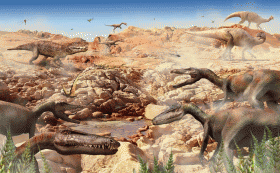Dinosaurs survived 2 mass extinctions and 50 million years before taking over the world and dominating ecosystems

Reporting in Biology Letters, Steve Brusatte, Professor Michael Benton, and colleagues at the University of Bristol show that dinosaurs did not proliferate immediately after they originated, but that their rise was a slow and complicated event, and driven by two mass extinctions.
"The sheer size of dinosaurs like Tyrannosaurus makes us think there was something special about these animals that preordained them for success right from the beginning," Brusatte said. "However, our research shows that the rise of dinosaurs was a prolonged and complicated process. It isn't clear from the data that they would go on to dominate the world until at least 30 million years after they originated."
Importantly, the new research also shows that dinosaurs evolved into all their classic lifestyles – big predators, long-necked herbivores, etc. – long before they became abundant or diversified into the many different species we know today.
Brusatte added: "It just wasn't a case of dinosaurs exploding onto the scene because of a special adaptation. Rather, they had to wait their turn and evolved in fits and starts before finally dominating their world."
Dinosaurs originated about 230 million years ago and survived the Late Triassic mass extinction (228 million years ago), when some 35 per cent of all living families died out. It was their predecessors dying out during this extinction that allowed herbivorous dinosaurs to expand into the niches they left behind.
The rapid expansion of carnivorous and armoured dinosaur groups did not happen until after the much bigger mass extinction some 200 million year ago, at the Triassic-Jurassic boundary. At least half of the species now known to have been living on Earth at that time became extinct, which profoundly affected life on land and in the oceans.
Historically the rise of the dinosaurs has been treated as a classic case in which a group evolves key features that allow it to rapidly expand, fill many niches, and out-compete other groups. But Professor Benton said the story isn't so simplistic: "We argue that the expansion of the dinosaurs took up to 50 million years and was not a simple process that can be explained with broad generalizations."
Source: University of Bristol


















